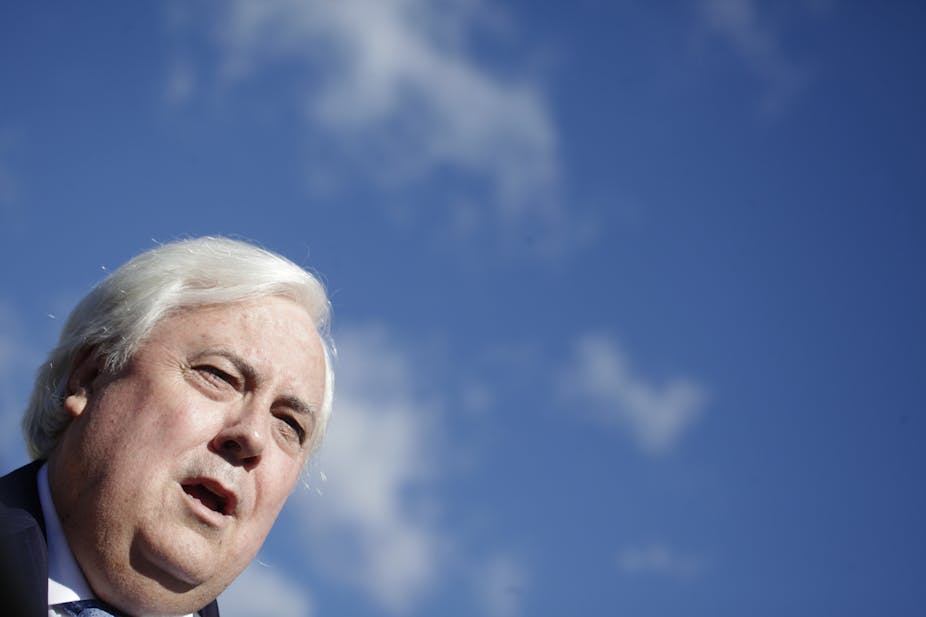Clive Palmer’s Waratah Coal claims its Galilee Coal Project, which will create four underground mines, two open-cut mines, and 468 kilometres of railway line in central Queensland, will bring economic prosperity to the region.
In its recently-released supplementary environmental impact statement, however, the company refused calls to release its modelling. Without it, the public are in the dark about the true costs and benefits of Palmer’s mega-mine.
Regional costs
When the company released its original environmental impact statement, it was quick to spruik the results of its economic modelling. But now, when people want to delve a little deeper into those results, the company has declared the modelling to be “commercial-in-confidence” (or confidential). This is like saying you’ve done the maths and the answer is “three”, but without anybody else knowing how you came to your answer.
The original environmental impact statement found, if the project goes ahead, Queensland’s agriculture, manufacturing and tourism sectors will experience significant job losses.
Clive Palmer’s own economic modeller projected that between 2013 and 2017 employment and output in Queensland manufacturing alone will fall by 2,215 jobs and A$1.3 billion respectively.
The environmental impact statement also admits the project will “eat into business profitability” and force a number of local businesses to close. This is because employers will have to push up their wages to retain key staff, and therefore push up prices to pay for them.
When a wage increase drives price increases for goods and services, the result is inflation. Much is made of the rising cost of living in Australia and there is ample evidence that big mining projects drive up the prices paid by the non-miners that live nearby. When The Australia Institute brought this to the attention of Waratah Coal, it simply replied that its impact statement “acknowledges” the risk of inflation.
Hanging on to the boom
If there is one thing that all economists can agree on it is that bust follows boom. Leaving to one side the short-term impacts of the mining boom, the surrounding region will also have to deal with the long-term costs. With depleted tourism, manufacturing and agricultural sectors, Queensland will have far less insulation against the full force of a mining bust.
The original environmental impact statement proposed that the construction of the mine would create a “dependence on coal and coal seam gas in the region”, which will mean that “fluctuations in global resource markets can potentially have grave impacts on the region.”
A diversified regional economy would mean that Queensland’s long-term future would not rely on the continuing success of any one particular industry, or the world price of one particular commodity.
While beef and sugar prices have always jumped around, and tourism numbers have risen and fallen with the strength of the Asian economies, if Queensland’s mega coal mines get the go ahead then the strength of the local economy will be tied to the world commodity markets like never before. Put simply, if the Galilee Coal Project goes ahead, towns like Alpha and Rockhampton are effectively betting that the mining boom will last forever.

As clear as coal
Waratah Coal’s decision to classify its economic modelling as “commercial-in-confidence” means the promises made by Waratah Coal must be taken at face value. Without publicly available data, what we know is far less than what they know.
The lack of transparency displayed by Palmer’s mining company highlights the dangers of relying on the proponent to summarise the costs and benefits of a project to the community.
Elsewhere in Australia the modelling produced by mining companies to “prove” that their projects deliver community benefits has been dismissed by the courts.
For example, the NSW Land and Environment Court Chief Justice Brian Preston recently found that Rio Tinto’s claims that their Mount Thorley Warkworth mine was in the public interest was not supported by the evidence. He was scathing of the economic modelling used by the mining company’s experts.
The modelling used for the Galilee Coal Project should also be scrutinised. Waratah Coal’s original impact statement promised that the project would create 70,000 indirect jobs. When this figure was questioned, they admitted in the supplementary statement that they made the claim in “error”.
By not even letting the public see how the company arrived at its figures, Waratah Coal is further undermining the community’s faith in a project that its own experts admit may have “grave impacts” for the region.
Queenslanders are being asked to take Clive Palmer’s Waratah Coal at its word. But when a company is set to profit from your trust, it’s best to be careful about giving it.

